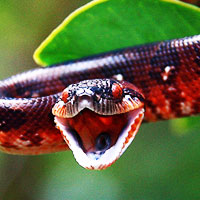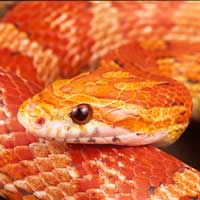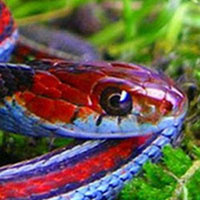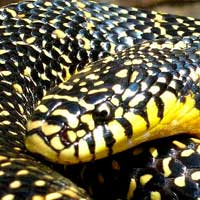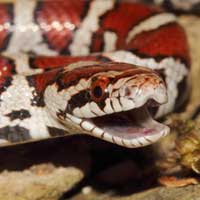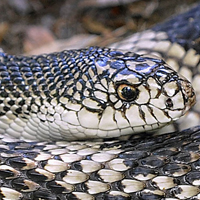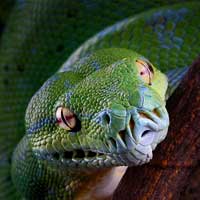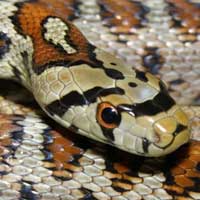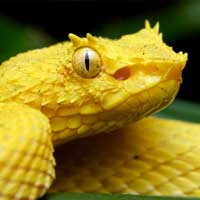Black Kingsnake: Everything You Need to Know About This Intriguing Species
The scientific name of the Black Kingsnake is Lampropeltis nigra. It belongs to the Colubridae family, which is the largest snake family and includes many non-venomous and mildly venomous species.
Scientific Name: Lampropeltis nigra
Snake Family: Colubridae
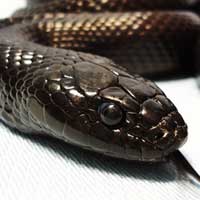
Introduction to the Black Kingsnake
The Black Kingsnake (Lampropeltis nigra) is a non-venomous snake known for its glossy black scales with subtle white or yellow speckling. Native to the southeastern United States, this snake is a hardy and adaptable predator. Its calm temperament and natural beauty make it a favorite among reptile enthusiasts and an essential component of its ecosystem, helping to control pest populations.
Where Does the Black Kingsnake Live?
The Black Kingsnake thrives in a wide range of habitats across its distribution in the southeastern United States. Its adaptability allows it to inhabit diverse environments.
Preferred Habitat Features:
- Woodlands and forests
- Wetlands and marshes
- Grasslands and open fields
- Suburban areas near water sources
| Region | Habitat Type | Key Features |
|---|---|---|
| Southeastern USA | Woodlands | Shaded areas, ground cover |
| Mississippi Valley | Wetlands | High humidity, abundant prey |
| Appalachian Region | Rocky hillsides | Shelter among rocks |
What Does the Black Kingsnake Eat?
The Black Kingsnake is a carnivorous predator with a diverse diet. Its role as a constrictor enables it to subdue and consume prey effectively.
Common Diet:
- Rodents such as mice and rats
- Birds and their eggs
- Lizards and amphibians
- Other snakes, including venomous species
In captivity, a diet of pre-killed or frozen-thawed rodents is recommended for safety and convenience. Juveniles should be fed every 5-7 days, while adults typically eat every 10-14 days.
Behavior and Temperament of the Black Kingsnake
The Black Kingsnake is known for its calm and inquisitive demeanor. Though initially shy, it adapts well to regular handling in captivity.
Key Behavioral Traits:
- Non-aggressive and docile
- Active during the day and early evening
- Displays defensive coiling and hissing when threatened
- Highly adaptable to different environments
With consistent handling, the Black Kingsnake becomes more comfortable around humans, making it an excellent pet for beginners and experienced keepers alike.
Health and Lifespan of the Black Kingsnake
With proper care, the Black Kingsnake can live up to 20 years in captivity. Its hardy nature makes it relatively easy to maintain, but attention to health and husbandry is essential.
Common Health Concerns:
- Respiratory infections from poor humidity control
- Parasites, especially in wild-caught specimens
- Shedding problems caused by insufficient humidity
Maintain an enclosure with a temperature gradient of 75-85°F, provide fresh water, and monitor the snake for any signs of illness. Regular check-ups with a reptile veterinarian are recommended.
Reproductive Traits of the Black Kingsnake
The Black Kingsnake is oviparous, laying eggs after mating in the spring. Reproductive behavior is influenced by seasonal changes in temperature and light.
Reproductive Details:
- Mating season: Spring
- Clutch size: 6-20 eggs
- Incubation period: 50-70 days
- Hatchlings are independent at birth
In captivity, providing a nesting area and maintaining the correct incubation temperature (82-85°F) is crucial for successful breeding and hatching.
Handling and Caring for the Black Kingsnake
Handling and caring for the Black Kingsnake requires attention to its natural behaviors and environmental needs. Its hardy nature makes it an ideal species for reptile enthusiasts.
Handling and Care Tips:
- Handle regularly to build trust and reduce stress
- Provide an enclosure with hiding spots and climbing branches
- Maintain a clean environment with proper humidity and temperature
- Offer a varied diet of appropriately sized prey
With the right care, the Black Kingsnake can thrive in captivity and offer years of fascination and enjoyment to its keeper.
